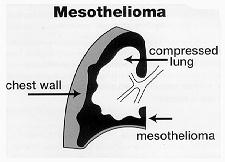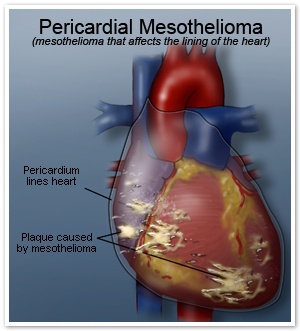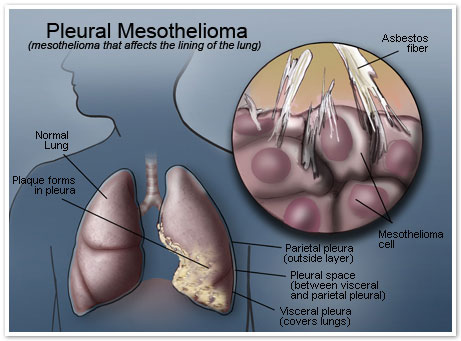 There are several risk factors that increase the likelihood that a person will develop mesothelioma. The main risk factor for asbestos. Exposure to extremely harmful substance can significantly improve the chances of contracting the disease. Other secondary factors include exposure to radiation, zeolite, simian virus 40 (SV40) and tobacco. We examine each of these risk factors detailed below.
There are several risk factors that increase the likelihood that a person will develop mesothelioma. The main risk factor for asbestos. Exposure to extremely harmful substance can significantly improve the chances of contracting the disease. Other secondary factors include exposure to radiation, zeolite, simian virus 40 (SV40) and tobacco. We examine each of these risk factors detailed below.Asbestos
Exposure to asbestos is the major risk factor for mesothelioma. Asbestos is an insulating material composed of fibers of magnesium silicate minerals. She was favored by builders and contractors for many years for its low thermal conductivity and resistance to melting and burning. As researchers have identified links between a growing mesothelioma and asbestos exposure, the material is less used. Before this discovery, however, millions of Americans have suffered a severe exposure to this harmful substance.
More than 700,000 schools and buildings in the U.S. Today, States contain asbestos insulation as reported by the U.S. Agency for Environmental Protection. Asbestos exposure does not stop there, however. Asbestos is often found in shipyards, factories, railways and construction sites. The workers are at greater risk of developing mesothelioma due to occupational exposure, and in particular those working in mines, factories, shipyards, construction sites, railways and insulation manufacturers and makers of gas masks. The occupations most affected are miners, factory workers, railroad workers, ship builders and construction workers - especially those who installed insulation containing asbestos. Sometimes family members related to exposure, the workers are second hand dust and asbestos fibers brought home the clothes of workers and also become a risk for mesothelioma.
asbestos fibers serpentine and amphibole are the two main types of asbestos used. Chrysotile is a serpentine fiber and more frequent use. These fibers tend to be curly and flexible. amphiboles, however, are generally straight and narrow and usually include one of five types: crocidolite, amosite, anthrophylite, tremolite, actinolite y. The type of amphibole crocidolite is thought to be the major contributor to cancer caused by asbestos. Serpentine fibers are dangerous as well, however, and is also associated with mesothelioma.
Some research results in the fact that inhalation of asbestos fibers cause a physical irritation resulting in cancer instead of cancer is caused by a reaction that is chemical in nature. As the fibers are inhaled through the nose and mouth, are removed from the body by adhering to mucus in the nose, throat and airways, then get expelled by coughing or swallowing. amphibole (long and thin) are not clear as easily and is thought to incorporate into the lining of the lungs and chest and result in mesothelioma.
The asbestosis (scar tissue in the lungs), or lung cancer can also be caused by the inhalation of asbestos. In fact, people exposed to asbestos seven times more likely to develop lung cancer during the hearing. Employees who have suffered a great exposure to asbestos is more likely to die from asbestosis, mesothelioma or lung cancer than any other disease. It is also believed that the action of coughing and swallowing asbestos could be promoted form of mesothelioma, the abdomen is called peritoneal mesothelioma. Mesothelioma has been observed in other organs, as well as the larynx, pancreas and colon, but these cases are very limited compared to the cases of lung cancer.
The possibility of developing mesothelioma is directly proportional to the duration and amount of exposure to asbestos, that the individual referred to above. People exposed to asbestos tall young age, and are at higher risk for a long time been diagnosed with mesothelioma than those who are short, low-risk. Another important aspect is that mesothelioma can take a long time the obvious. Often twenty to forty years to run when the exposure to the diagnosis. Genetic factors may influence which explains why not everyone exposed to asbestos and asbestos-related diseases.
Radiation
thorium dioxide (Thorotrast), a substance used in X-ray tests in the past has reported links with pleural mesothelioma and peritoneal mesothelioma. The use of Thorotrast was abandoned for many years due to this discovery.
Zeolite
Some cases of mesothelioma in the region Anatoli Turkey was bound to zeolite, a mineral made of silica with chemical properties similar to asbestos in the soil there.
Simian virus 40 (SV40)
Some scientists have found that simian virus 40 (SV30) in mesothelioma cells in humans and were able to create mesothelioma in animals with the virus. The relationship between this virus and mesothelioma is not clear, however, more research is underway to gain clarity on this potential link.
Tobacco
Smoking is associated with him, not only mesothelioma, but smokers who are exposed to asbestos have a higher chance of developing lung cancer (as well as top 50 to 90 percent). Research indicates that lung cancer is the leading cause of death in asbestos workers.
















